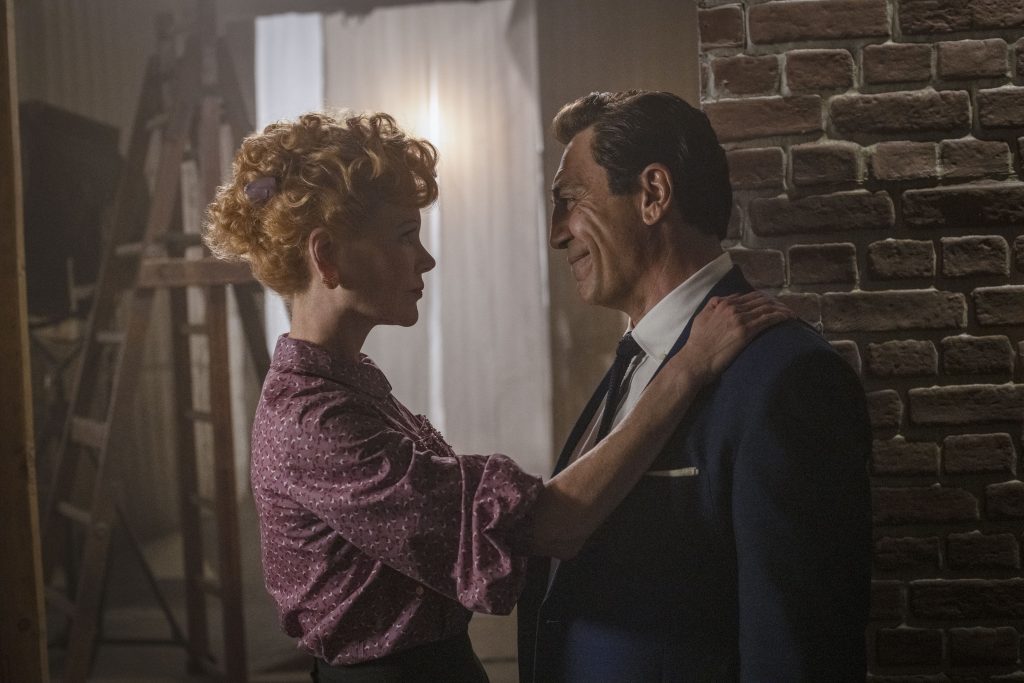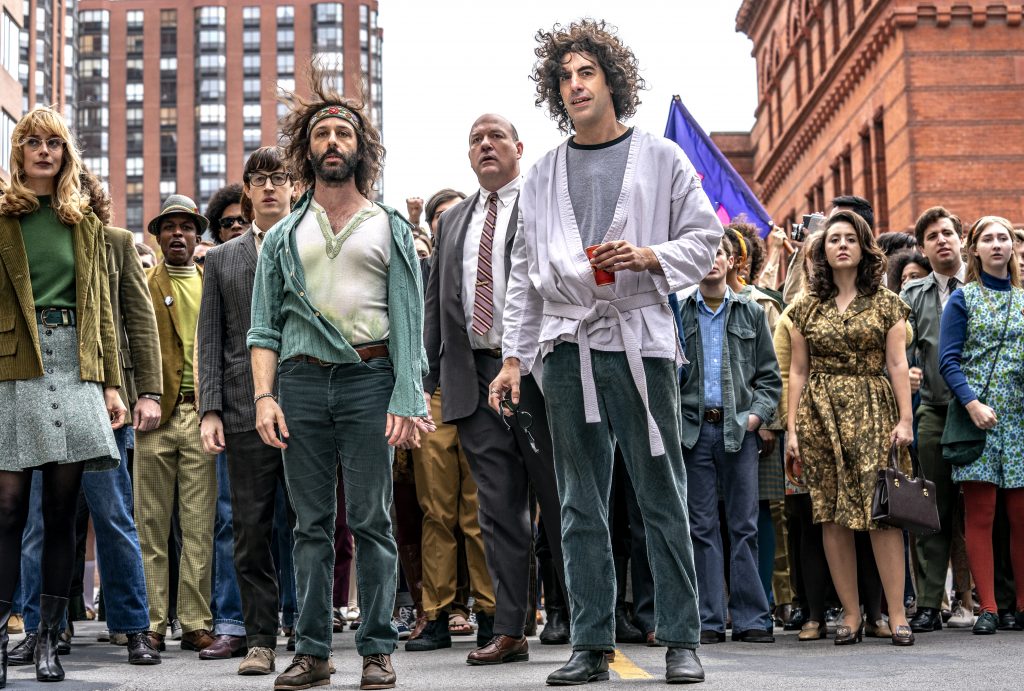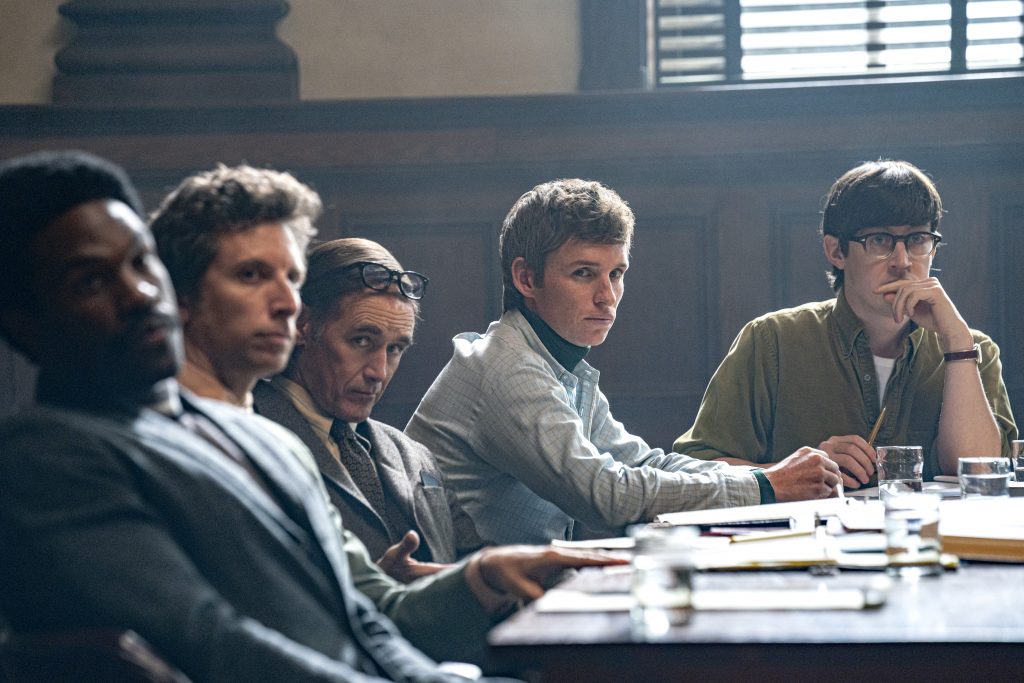December 7, 2021
by Carla Hay

Directed by Aaron Sorkin
Culture Representation: Taking place in 1952, mostly in the Los Angeles area, the dramatic film “Being the Ricardos” features a predominantly white cast of characters (with a few Latinos) representing the working-class, middle-class and wealthy.
Culture Clash: “I Love Lucy” co-stars and spouses Lucille Ball and Desi Arnaz have conflicts in their marriage over her suspicions that he’s been cheating on her; how they should handle a possible scandal that Ball has been labeled a Communist; and what decisions should be made about creative control of the show.
Culture Audience: “Being the Ricardos” will appeal primarily to people who are fans of “I Love Lucy”; “Being the Ricardos” co-stars Nicole Kidman and Javier Bardem; writer/director Aaron Sorkin; and movies about the Communist witch hunt/Red Scare that affected Hollywood in the 1950s.

The very talkative drama “Being the Ricardos” skillfully chronicles the power struggles and conflicts affecting the marriage of Lucille Ball and Dezi Arnaz during one tension-filled week of 1952. Because this movie was written and directed by Aaron Sorkin (former showrunner of “The West Wing”), expect to see a lot of themes about people feeling persecuted by a government that oversteps its bounds on personal freedoms. All of the cast members give admirable performances, despite Sorkin giving his movies a self-conscious “showboating” and “awards bait” tone that is sometimes distracting.
“Being the Ricardos” is the third movie directed and written by Sorkin, who previously helmed 2017’s “Molly’s Game” and 2020’s “The Trial of the Chicago 7.” All three movies are based on real people and true events. And all three movies have government scrutiny as major elements of the story. Ball and Arnaz are not in danger of going to prison like the protagonists of “Molly’s Game” and “The Trial of the Chicago 7.” However, this showbiz couple will face a different type of imprisonment of “Hollywood jail,” if they are labeled as “Communist traitors” during the Cold War era in the U.S., where being labeled a Communist could derail careers and ruin lives. In the movie, Ball is exposed in a newspaper article as having registered to vote years before as a member of the Communist Party.
Because the movie’s main storyline takes place over one week, “Being the Ricardos” uses flashbacks to fill in some of the context blanks and give viewers some background on the relationship between Ball (played by Nicole Kidman) and Arnaz (played by Javier Bardem), who got married in 1940. At the time that they met, Ball was a B-level actress doing mostly supporting roles in movies and reluctantly performing in radio. Arnaz was a Cuban immigrant who was leader of the Desi Arnaz Orchestra, where he played conga drums and sang lead vocals.
According to the way their courtship is portrayed, Ball was the one who was wary of commitment at first because of Arnaz’s reputation for being a playboy and because she didn’t want to give up her independence. However, Arnaz quickly charmed Ball, and they married after less than a year of dating. He constantly flattered her with praise about her talent and encouraged her to seek projects where she could be the star, not a supporting actress in mostly forgettable roles.
When television came along as a relatively new medium for entertainment, the timing was right for Ball to become a star on TV. She got an offer to adapt her comedy radio show “My Favorite Husband” into a TV series. She agreed, on the condition that her real-life husband would co-star in this comedy TV series that was loosely based on their real-life marriage. And that’s how “I Love Lucy” was born in 1951, with Ball and Arnaz portraying spouses named Lucy Ricardo and Ricky Ricardo. In 1951, Ball was 40 years old, and Arnaz was 34.
Ball and Arnaz maintained a great deal of creative control of the show through their company Desilu Productions. (They were both had the title of executive produder.) “I Love Lucy” was televised in the U.S. on CBS, which was owned by Westinghouse at the time. Much of “Being the Ricardos” shows the conflicts between the couple and executives from CBS, Westinghouse or show corporate sponsor Philip Morris (which was a politically conservative company), as well as with some members of the show’s creative team.
Sorkin took an unusual approach by having this particular week of Ball’s and Arnaz’s lives narrated in the 2000s decade by three people who were key players in the “I Love Lucy Show”: executive producer/head writer Jess Oppenheimer (played by John Rubinstein in the 2000s and Tony Hale in the 1950s); writer Madelyn Pugh (played by Linda Lavin in the 2000s and Alia Shawkat in the 1950s); and writer Bob Carroll Jr. (played by Ronny Cox in the 2000s and Jake Lacy in the 1950s). It’s a good idea that mostly works well for the structure of the story, mainly because having the movie narrated by Ball or Arnaz might veer into unreliable narration.
People who watch “Being the Ricardos” should not expect it to be a series of re-enactments from “I Love Lucy” episodes. There are brief parts of the movie that show a few iconic scenes from “I Love Lucy,” most notably the episode titled “Lucy’s Italian Movie,” where Lucy goes to Rome and is comedically clumsy when stomping grapes in a vat. It’s in these sitcom episode recreation scenes where Kidman stands out the most in a stellar interpretation of Ball.
Ball had a fun-loving persona on-screen that was very different from her hard-driving, demanding and competitive personality off-screen. The movie shows that this real-life personality was formed in large part because of Ball’s lifelong insecurities of feeling that she could never really have a place that she could call a permanent home. In her childhood, her family moved around a lot. At one point in her childhood, Ball was sent to live with her stepfather’s parents. And when she was 14, she moved to New York City by herself to pursue a professional career in the entertainment business.
There are many hints that Ball’s unstable childhood contributed to her rebellious nature. In a scene where she’s on one of her first dates with Arnaz (he teaches her how to rumba), he asks her what she’s doing there. She says it’s because she was kicked out of acting school in New York. The morning after they first spend the night together, she and Arnaz are in bed and she nonchalantly tells Arnaz that she has a fiancé. She then calls this fiancé on the phone to and break up with him. During this brief breakup conversation, she tells the fiancé that she doesn’t love him and she doesn’t like the way he treats her.
Arnaz had his own issues, as a Cuban immigrant who had to deal with racism in the United States, but these racism issues are mostly ignored in the movie. He was one of the first Latino stars of American television, but the movie implies that it’s because he was married to a white woman. Because they were a power couple, Arnaz was able to get a lot of access and clout that he might not have gotten if he had been married to someome who wasn’t white. In the 1950s, there were no American TV shows starring non-white actresses.
Whereas Ball longed to have a stable home life where she felt truly settled down, Arnaz wasn’t willing to give up his nomadic life as a touring performer. During the years that “I Love Lucy” was on the air (1951 to 1957), he continued his music career with constant touring. Arnaz and his band (which was renamed the Ricky Ricardo Orchestra) also did regular performances, often five times week, at venues in the Los Angeles area, such as the nightclub Ciro’s. (Bardem does his own singing in the movie—and he’s quite good.)
There are three issues that Ball and Arnaz contend with during the course of the movie. First, the press (namely, gossip columnist Walter Winchell) has unearthed information that Ball is registered to vote as a member of the Communist Party. This possibly career-ending information is reported during the height of the Red Scare in America, where people suspected of being Communists were blackballed in their industries and often had their lives ruined.
Ball has an explanation for being a registered Communist: When she was younger, her stepfather Fred was a Communist. When it came time for her to register to vote, she just “checked a box” that happed to say “Communist,” in order to please Fred. Ball assures anyone who asks that she’s not a practicing Communist and doesn’t believe in the Communist Party. She quips, “Back then, being a Communist was no worse than being a Republican.”
However, she and Arnaz disagree on how honest she should be about her decision to check that Communist Party box on her voter registration. Arnaz thinks that Ball should tell people that she never intended to check the box, while Ball thinks that she should tell people that she did intend to check it, but there was she never had any real loyalty to the Communist Party. The potential scandal doesn’t really gain traction, despite Winchell’s repeated efforts. The movie spends a lot of time on Arnaz trying to be the protective husband in preventing Ball from being hurt by the Communist accusations.
Second, Arnaz’s suspected infidelities had become fodder for the tabloid press, which often published photos of him in the company of other women while he was married to Ball. And those issues are always brewing in the couple’s turbulent relationship. Smooth-talking Arnaz always has an explanation that Ball seems desperate to believe. The movie gives the impression that Arnaz was relieved that the possible Communist scandal was distracting his wife from the media reports that he was cheating on her.
I’s eventually revealed that Arnaz isn’t even sleeping at their house and spends part of the week in a hotel. His reason for staying is a hotel is that when he works late (up until 4 a.m.) for his band performances, he doesn’t want to disturb his wife when coming home from the club. She has to get up early to be on the TV set before dawn. Arnaz is rarely seen during the scenes where the cast is doing table readings of the script.
At one point in the movie, Ball mentions that her work schedule and Arnaz’s work schedule means that they hardly spend time together at home. It fuels her insecurities over never having a traditional home life. And so, it’s quite “on the nose,” when Arnaz utters the famous Ricky Ricardo line, “Lucy, I’m home,” during filming of an ” Love Lucy” episode, and the movie shows Ball giving a big pause and forgetting her lines, as if she’s triggered by these words.
Third, there were issues of control over the content and direction of “I Love Lucy,” which was on television at a time when married couples weren’t allowed to be seen sleeping in the same bed, and pregnancies were considered a taboo topic for scripted TV series. As many people know, Ball and Arnaz changed the rules of how pregnancies were depicted in scripted series. “Being the Ricardos” shows the couple insisting that Ball’s real-life pregnancy be written into “I Love Lucy” episodes, with Lucy Ricardo also being pregnant in the same timeline.
But the battle with CBS, Westinghouse and Philip Morris over this pregnancy storyline got even more contentious when Ball and Arnaz also demanded that there should be an entire episode about the birth of the child. It was unheard-of at the time, and the corporate executives were certain that audiences would be offended. Instead, the birth of Lucy and Ricky’s child (Ricky Jr.) became the highest-rated TV episode at the time. (In real life, Ball gave birth to Desi Arnaz Jr. on January 19, 1953, and he played the role of Ricky Jr. on the show.)
“Being the Richardos” also explores the dynamics of the co-stars who played the Ricardos’ two best friends Fred Mertz and Ethel Mertz on “I Love Lucy.” In the role of Fred was William Frawley (played by J.K. Simmons), a cranky alcoholic, who often clashed with Ball on how he should act in scenes. In the role of Ethel was Vivian Vance (played by Nina Arianda, who gives a fantastic performance), who was a close friend of Ball’s in real life, but who resented that Ball wanted to keep Ethel as a frumpy and slightly overweight character.
There’s a series of scenes in “Being the Ricardos” where Vance figures out that Ball came up with an underhanded scheme to try to prevent Vance from looking thin and attractive. It starts when Vance is told by a wardrobe person that her Ethel character can’t wear a fancy gown in a scene, as originally planned. Ethel has to wear a dowdy dress instead. Vance is disappointed by this wardrobe change, but she doesn’t inquire too much over who made this decision.
But slowly, the clues starts to add up. Ball makes a point of commenting to Vance that she’s noticed that Vance has lost weight. Not long afterward, on another day, Pugh arrives in Vance’s dressing room with a calorie-heavy breakfast for Vance to eat, but Vance did not request this meal. Why is a show’s writer doing the work of a production assistant of bringing her breakfast? And who ordered that this meal be delivered to Vance? Vance has an “a-ha” moment and confronts Ball about this intention to sabotage Vance’s weight.
Die-hard fans of Ball already know many behind-the-scenes stories about how she could be this catty and insecure with Vance, because Ball did not want to be outshined by anyone (especally another woman) on Ball’s TV shows. Even though Vance and Ball were close friends, “Being the Ricardos” makes it clear that Ball’s top priority in life was herself. That didn’t mean that she was incapable of love but that she learned from an early age that self-preservation is the best way to get through life.
However, Vance is not a shy and introverted co-star. She expresses her annoyance at some of these indignities of being treated like a subservient “second banana.” But ultimately, Vance knows who’s in charge and has no choice but to go along with executive decisions, in order to keep her job. When it comes down to it, Vance values her friendship with Ball more than any ego competitions that they might have had over their very different roles in “I Love Lucy.”
“Being the Ricardos” has all the elements of an awards-bait movie. And there’s not a bad performance or technical aspect in the end results. But somehow, everything still feels too staged. And just like Sorkin’s other movie screenplays, “Being the Ricardos” can get overly talkative to the point where it might bore some viewers in certain parts of the film. The movie total running time (125 minutes) could have been trimmed a little more. For example, there’s an unnecessary flashback scene where Ball finds out that she got a co-starring role with Henry Fonda in the 1942 movie “The Big Street,” after Rita Hayworth dropped out of the role.
Some viewers might also be distracted by the fact that when Ball is not filming her TV shows, her famous bright red, tightly curled hair is not the type of hairstyle that she has for most of the movie. Instead, for most of “Being the Ricardos,” Ball is seen wearing a wavy hairstyle with a strawberry blonde shade. In flashback scenes showing her pre- “I Love Lucy” courtship with Arnaz, Ball has hair is dark auburn red. Because Ball’s curly, bright red hair was such a big part of her her image, when she doesn’t have this hairstyle, Kidman looks a lot less convincing as Ball.
During table reads of the episode scripts and in meetings with executives, Ball is assertive in expressing what she wants. She and Arnaz also clash with Oppenheimer over his direction of the show. These table-reading scenes also give some insight into the opposite personalities of Rawley and Vance. When Vance expresses sympathetic dismay over teenage actor Rusty Hamer was forced to sign a loyalty pledge after being accused of a Communist, Rawley is gruffly unmoved because Rawley thinks that all Communists in America should be severely punished.
There are hints of domestic abuse in the couple’s relationship. During an early scene, Ball can be heard off-screen, hitting Arnaz in anger and yelling at him. And the older Pugh says in hindsight of the couple’s marriage: “They were either tearing their heads off, or tearing their clothes off.”
Some viewers might want to see detailed depictions of this behind-the-scenes marital strife. But when you consider that Lucie Arnaz, the daughter of Ball and Desi Arnaz, is an executive producer of “Being the Ricardos,” graphic scenes of domestic abuse just weren’t going to be this movie. Lucie Arnaz has gone on record saying that she enthusiastically approves of Kidman’s portrayal of her mother.
“Being the Ricardos” certainly as its high points when it comes to acting and recreating the fashion and locations depicted in the movie. And yet, there still seem to be some things that seem left out of the movie because maybe the family members didn’t want to tarnish the legacy with some ugly secrets. If audiences know before seeing the movie that it won’t be a comprehensive history of Ball, Desi Arnaz or “I Love Lucy,” but rather that it’s a snapshot of a challenging period in the couple’s marriage, then there’s a better chance of enjoying “Being the Ricardos.”
Amazon Studios will release “Being the Ricardos” in U.S. cinemas on December 10, 2021. Prime Video will premiere the movie on December 21, 2021.


